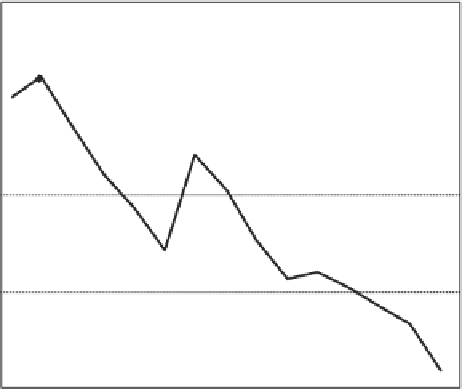Environmental Engineering Reference
In-Depth Information
20
25
Storage accretion
0
0
Storage depletion
-25
-20
-50
-40
-75
-60
Figure 9.3
Cumulative changes in groundwater storage in the High Plains Aquifer since 1987 (1 acre-foot
=
1233.5 m
3
).
From McGuire, 2003.
contaminated, the microbial load is low as well. In most cases, filtration followed by
chlorination is enough to make well water potable. However, not all groundwater is of
premium quality because the presence of certain chemical compounds and organisms can
compromise the quality of groundwater. Some problems that can be encountered are exces-
sive hardness, high content of salt or iron, excessive bacterial contamination and pesticides, or
the presence of hydrogen sulfide, methane gas, and petroleum. Hardness, iron, and sulfur are
inherent well water problems that can be treated. However, the other contaminants are more
difficult to eliminate economically, and in most cases, wells are abandoned (Waller, 1994).
In coastal areas, deterioration of water quality happens mainly as a consequence of excessive
pumping that leads to inland saltwater intrusion, which results in salt contamination of the
water supply.
Yet the most important problem with aquifers is depletion. Without exception, aquifers
around the world are pumped at rates that exceed the rate of recharge, which will eventually
lead to the exhaustion of the water resources. Excessive pumping lowers the water table,
reduces water in streams and lakes, increases the cost of pumping, deteriorates water quality,
and produces land subsidence. Land subsidence is the result of loss of support below ground,
which causes the ground in some places to collapse (US Geological Survey [USGS], 2003).
Figure 9.3 shows the decreasing level of the High Plains Aquifer located in US Midwest,
which is also known as the “Breadbasket of the World” (Rodell and Famiglietti, 2002). This
example is for a particular well in one aquifer, but it is typical of what is happening in most
aquifers around the world.
Sustainable use of groundwater resources can be accomplished only by pumping at a rate
equal or lower than the rate of recharge. In the case of nonrechargeable aquifers, there is no pos-
sibility of sustainable exploitation. The rate of extraction is not easy to calculate because the
impact of human activity changes the natural recharge patterns. The study of the safe rate of
extraction is known as “water budgets” (for more information, see USGS Circular 1186 [1999]).

















